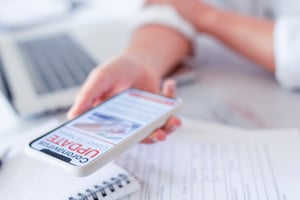An emergency communication system is paramount for any organization, but in the healthcare industry, it is absolutely vital. In the following blog, we cover some of the more recent challenges faced by our healthcare customers, such as the inability to reach everyone in certain medical facility environments, the uptick in workplace violence in the healthcare industry, and the impact the pandemic has had on staffing shortages.
Reaching All Stakeholders in a Healthcare Facility With Mass Alerts
Something that we often hear is that healthcare facilities may not allow phones or may have very weak cell phone service. In those situations, how do you reach all of your stakeholders when an emergency arises?
Best practice is to utilize every communication channel possible to keep your people safe and informed. The likelihood your recipients will see or hear your message will increase with each additional line of communication. We suggest putting an emergency communications system in place that will enable you to launch a mass alert simultaneously through all the various channels, whether that be mass text, email, phone calls, emergency notification apps, digital signage, etc. You must ensure your emergency mass notification system has these native endpoints or can easily integrate with third party emergency communication channels.
Specific to emergency apps, estimates suggest that only 7% of your stakeholders actually download them and only 10% of those users enable location services. That means you can only reach 7% of your audience through the emergency mass alert app and that the super geo-location features the emergency app vendor claimed would revolutionize your emergency messaging system are only effective with less than 1% of your base.
Omnilert enables you to overcome these obstacles and achieve 100% installation by making the safety app user interface available in both "Native" and "Instant" app formats. The Instant App ensures the rich functionality of the emergency alert app can always be accessed by subscribers. It is as if you had 100% app installation and adoption.
Workplace Violence in a Healthcare Facility
It is no secret that nurses and doctors face an outsized threat of workplace violence. In fact, according to a 2016 report from the U.S. Government Accountability Office, the rate of healthcare workers that require days off from work due to workplace violence-related injuries is four times higher than that for private-sector employees overall.
Fortunately, there are new and emerging applications for mass notification technology in hospitals. For instance, Omnilert Gun Detect integrates with existing video surveillance cameras to automatically detect when a gun is drawn and send out a mass alert. The visual gun detector used in conjunction with mass notification software reduces the time from first sighting to mass alerting to a handful of seconds and can ultimately save lives.
Existing gun detector technologies only work after incidents have escalated and provided vague details on the approximate location of the sound. In comparison, Gun Detect gives emergency response teams advance warning before shots are fired and delivers precise information on the location and visuals of the potential shooter.
COVID-19 and Healthcare Staffing Shortages
Despite the fact that hospitals are taking every precaution possible to keep employees safe, doctors and nurses regularly come into close contact with sick individuals as part of their jobs, and many have unfortunately become sick as a result. Furthermore, most people are understandably not eager to work in hospitals right now, which has made it extremely difficult for healthcare facilities to replace sick or departing staff.
With that said, there are emergency communication systems available to assist with getting coverage for shifts. A simple yes/no poll can be sent out to specified groups to determine availability. Along those lines, the same technology can be used to send COVID-19 self check-in polls to staff each day to determine their fitness. We also heard from a customer recently that used the emergency alert app to announce when it was time to come and get the COVID-19 vaccine.
Software-based automation, such as that provided by emergency notification systems, can supplement manual efforts to improve accuracy, speed, and cost. The polling functionality in safety apps can be leveraged by sending a question with several response options and viewing the responses in aggregate for targeted follow-up.
Emergency communications lie at the heart of public health. Recent experiences during the coronavirus pandemic have demonstrated the value of having the right infrastructure in place to issue timely health mass alerts and warnings.

